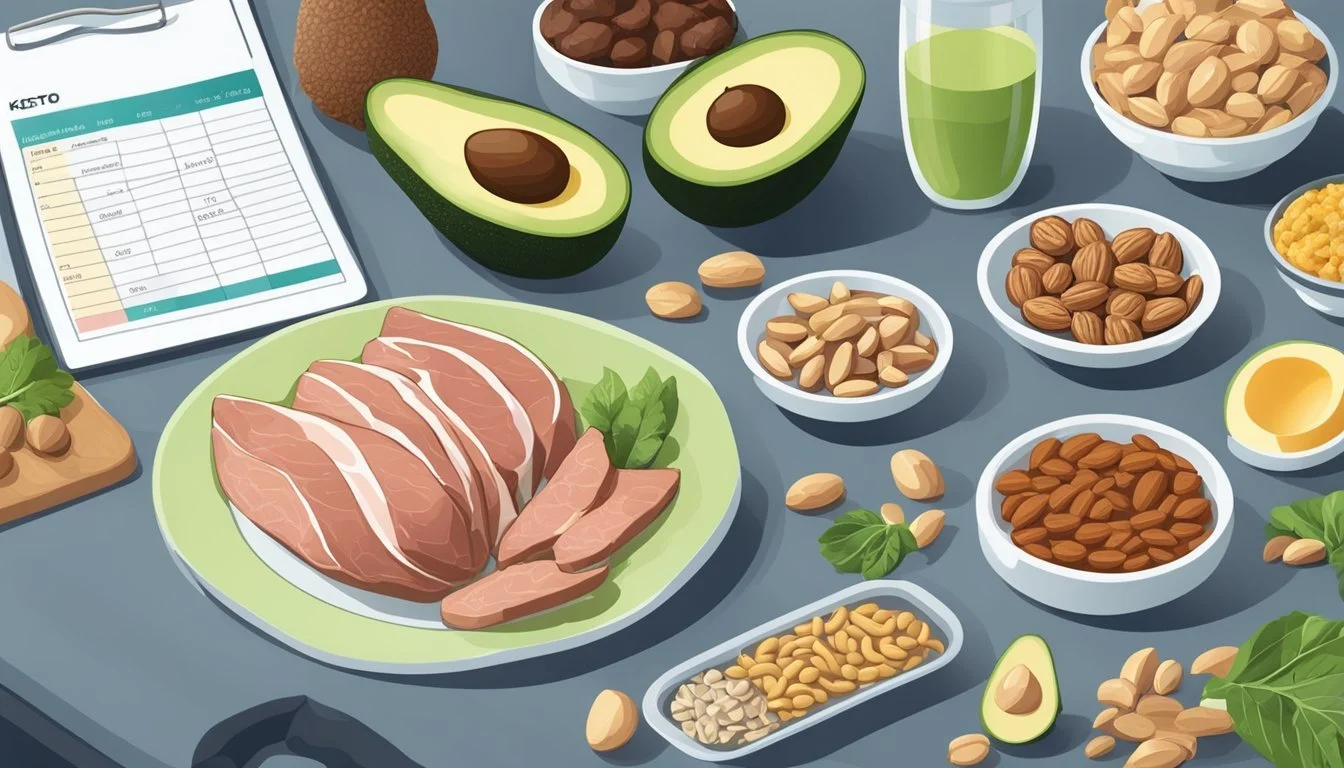Keto Diet in the Golden Years
Optimizing Health and Wellness
The ketogenic diet, often simply referred to as the keto diet, has garnered attention for its potential benefits in weight management, particularly among older adults in their golden years. By altering macronutrient intake to a high fat, moderate protein, and low carbohydrate composition, the keto diet aims to usher the body into a state of ketosis, where it burns fat for fuel instead of carbohydrates. This dietary regimen may be an attractive option for seniors seeking to navigate the challenges of weight management during a stage of life often characterized by a naturally slower metabolism.
As individuals age, maintaining a healthy weight can become increasingly difficult. Metabolic processes slow down, and the body may not respond to traditional diets or exercise as efficiently as it once did. The keto diet's emphasis on fat can potentially offer a satiating effect, potentially reducing appetite and aiding in caloric control, which is a substantial concern for many older adults aiming to sustain a balanced lifestyle.
However, the adoption of the keto diet among seniors warrants careful consideration of their unique nutritional needs. It is imperative to ensure adequate nutrient intake and consult with health professionals to tailor the diet to accommodate any age-related dietary restrictions. This personalized approach helps in mitigating potential risks and aligning the keto diet strategy with the goal of improved overall health in the later years of life.
The Basics of Keto Diet
The ketogenic, or keto, diet emphasizes a low-carb and high-fat intake, manipulating the body's metabolism to use fats as a primary energy source.
Defining Ketosis and Ketogenic Diet
Ketosis is a metabolic state in which the body, deprived of glucose from carbohydrates, starts to break down stored fat, resulting in the production of molecules called ketones. The ketogenic diet is a regimented eating plan that aims to induce this state by drastically reducing carbohydrate intake and increasing the consumption of healthy fats.
Macronutrients Breakdown
On a ketogenic diet, macronutrients are distributed primarily among fats, proteins, and carbohydrates. The typical breakdown is:
Fats: 70-80% of daily calories
Proteins: 20-25%
Carbohydrates: 5-10%, or about 20 to 50 grams per day
This distribution encourages the body to switch its energy source from glucose to ketones.
Health Benefits of Keto
Proponents of the keto diet claim that it can help the body burn more fat and reduce hunger. Health benefits attributed to this diet include weight loss, improved blood sugar levels, and enhanced mental clarity. However, individuals should consult health professionals before starting the diet to ensure it aligns with their specific health needs.
Nutritional Considerations for Seniors
As they age, seniors must carefully adapt their diets to meet changing nutritional requirements. This includes considering how a keto diet can satisfy their needs for protein, fiber, hydration, and essential minerals.
Adapting Keto to Nutritional Needs
The ketogenic diet for seniors should be tailored to meet decreased energy needs while ensuring adequate nutrition. Aging bodies often require higher intakes of vitamins and minerals, such as calcium and vitamin D, to maintain bone health. Moreover, due to a natural decrease in lean muscle mass, protein intake should be optimized to preserve muscle tissue, typically between 1.0-1.2 grams of protein per kilogram of body weight.
Balancing Macronutrients
The balance of macronutrients in a senior's keto diet is paramount. While the standard ketogenic diet comprises mainly fat, with moderate protein and very low carbohydrates, seniors need a modified macro split to support their health:
Fat: 60-75% of daily calories
Protein: 15-30% of daily calories
Carbohydrates: 5-10% of daily calories
Fiber is a significant consideration within carbohydrate intake, as it aids in digestion and helps prevent constipation, a common concern among seniors.
Importance of Hydration and Minerals
Seniors are more prone to dehydration; hence, they should pay careful attention to hydration. Consuming sufficient fluids helps the body manage the diuretic effect commonly experienced during ketosis. Besides water, seniors should incorporate a variety of minerals like sodium, potassium, and magnesium to support electrolyte balance, which is crucial on a ketogenic diet to avoid issues such as cramps and fatigue.
Potential Health Benefits and Risks
In considering the ketogenic diet during the golden years, it is crucial to weigh its health benefits, such as weight loss and improved metabolic health, against the potential risks like increased cholesterol and the onset of the keto flu.
Weight Management and Metabolic Health
The ketogenic diet can lead to significant weight loss and reductions in body fat, which is achieved by the body entering a state of ketosis, where it burns fat for energy. This process can also improve insulin sensitivity and lead to lower blood sugar levels, which are particularly beneficial for managing diabetes. However, there are associated risks such as nutrient deficiencies and the potential for a rise in low-density lipoprotein (LDL) or "bad cholesterol" which may be a concern for heart health.
Cognitive Function and Neurological Health
Some studies suggest that the ketogenic diet boosts mental clarity and cognitive function due to the enhanced energy supply from ketones. This diet has been studied for its potential to lower inflammation in the brain and may offer benefits in neurological conditions. Nevertheless, firm conclusions cannot be drawn yet, and long-term effects on cognitive health are still under investigation.
Cardiovascular Effects and Diabetes Control
The effects of a ketogenic diet on cardiovascular health are two-fold. On the one hand, a reduction in triglycerides and increase in HDL cholesterol (good cholesterol) could be heart-protective. On the other, an increase in LDL cholesterol could heighten the risk of heart disease. For individuals with diabetes, the low-carb approach can significantly lower blood sugar levels and reduce the need for insulin.
Understanding the Keto Flu and Side Effects
Adopting a ketogenic diet can result in the "keto flu," a group of symptoms including nausea, headaches, and fatigue, as the body adapts to ketosis. These side effects typically subside after the initial period. Other potential side effects include constipation and kidney stones, emphasizing the need for medical supervision when considering this diet in older adults.
Keto Diet and Physical Activity
Adhering to a ketogenic diet may influence an individual's energy levels, which can impact their physical activity routines. For seniors, understanding this relationship is crucial to ensure safe and effective exercise habits.
Exercise and Energy Levels
When a senior follows a ketogenic diet, their body primarily relies on fat for energy, which can lead to a stable energy source once they are fully adapted to the diet. Initially, they may experience a period of decreased stamina as their body transitions from using carbohydrates to fats for fuel. It's essential for seniors to monitor changes in their energy levels and adjust their exercise intensity accordingly.
Initial Phase:
Possible low energy levels
Reduced exercise intensity recommended
Adapted Phase:
Stable energy levels
Potential for gradual increase in exercise intensity
Safe Practices for Seniors
As seniors incorporate physical activity while on a ketogenic diet, safety is paramount. They should begin with low-impact exercises and consider consulting with healthcare professionals to tailor an exercise plan suited to their individual health status. Seniors must stay hydrated and ensure adequate electrolyte intake to counteract the diuretic effect of the ketogenic diet.
Recommended Low-Impact Exercises:
Swimming
Cycling
Walking
Tai Chi
Safety Checklist:
Consult with a health professional before starting
Hydrate well before, during, and after exercise
Monitor electrolytes
Listen to the body and adjust as needed
Foods to Include and Avoid
When embarking on a Keto diet during the golden years, it is crucial to focus on nutrient-dense foods while steering clear of high-carb items to maintain a state of ketosis.
Fats and Oils
Fats and Oils are the cornerstone of the Keto diet. They should focus on healthy sources to support overall well-being.
Include:
Olive oil: ideal for salads and low-heat cooking.
Avocado oil: great for high-heat cooking.
Avoid:
Highly processed vegetable oils: can contain trans fats which are detrimental to heart health.
Proteins and Vegetables
Proteins should be lean and high-quality, while Vegetables should be low in carbohydrates but high in fiber.
Include:
Eggs: a versatile source of protein.
Broccoli and salad greens: packed with nutrients and low in carbs.
Avoid:
Vegetables high in starch, such as potatoes and corn, go against Keto principles.
Fruits and Alternatives
Fruits are often limited on Keto due to high sugar content, but there are exceptions.
Include:
Berries: such as strawberries and raspberries in moderation as they have lower net carbs.
Avoid:
Tropical fruits: like mangoes and pineapples that are high in sugar and can disrupt ketosis.
Beverages and Snacks
Beverages and snacks should complement the Keto diet without adding excessive carbs.
Include:
Water, herbal tea, and bone broth: for hydration and nutrients without carbs.
Nuts: in moderation for a healthy snack rich in fats.
Avoid:
Sugary beverages and snacks: these high-carb items can halt ketosis and impede progress.
Meal Planning and Recipes
Crafting a ketogenic meal plan in one's golden years requires a thoughtful approach to nutrition, ensuring that the plan includes a variety of nutrients to support health while adhering to the low carbohydrate ethos of the ketogenic diet.
Creating a Balanced Keto Plan
A balanced keto meal plan for seniors should carefully manage caloric intake while emphasizing nutritious foods that are low in carbohydrates and sugar-free. It's important to include a variety of protein sources, such as pork chops (What wine goes well with pork chops?) and eggs, paired with an abundance of low-carbohydrate vegetables like cauliflower (how long does cauliflower last?), which can be used to make cauliflower rice, a popular substitute for traditional rice.
Sample Meal Ideas:
Breakfast: Egg muffins with spinach and cheese
Lunch: Grilled pork chops with a side of cauliflower rice
Dinner: Zucchini noodles with a creamy alfredo sauce and chicken
Simple and Nutritious Recipes
Recipes for seniors following the keto diet should not only center around nutritional value but also ease of preparation. Egg muffins, for instance, can be a convenient breakfast option; they can be made in batches and stored for a quick, satisfying start to the day. Zucchini noodles are a healthy, simple alternative to pasta, and when topped with a sugar-free sauce, they provide a delicious meal that aligns with keto principles.
Nutritious Recipes:
Breakfast: Egg muffins: Beat eggs and pour into muffin tins with diced vegetables and cheese, then bake.
Dinner: Pork chops with herb butter: Sear chops, then finish in the oven and top with a dollop of homemade herb-infused butter.
Eating Out and Social Events
Navigating social events and dining out can be challenging on a keto diet. Individuals should seek out restaurants that offer dishes with the necessary modifications, such as sugar-free dressings and low-carbohydrate options. When attending social gatherings, they can opt for dishes like meat and cheese platters or salads that align with their dietary restrictions. Communicating dietary preferences when RSVPing to events can also ensure suitable options are available.
Dining Out Tips:
Look for grilled protein options and swap out high-carb sides with vegetables.
Ask for dressings and sauces on the side to avoid hidden sugars.
Challenges and Solutions
Embarking on a ketogenic diet in one's golden years presents unique challenges, but with the right strategies and support, these can be effectively managed.
Managing Cravings and Social Pressure
Challenges: Individuals often face powerful cravings for high-carbohydrate foods and social pressure to partake in non-keto-friendly meals, which can hamper dietary consistency.
Cravings:
Consume foods high in healthy fats and fiber to increase satiety.
Keep keto-friendly snacks on hand to mitigate the temptation to consume carbs.
Social Pressure:
Prepare by having a meal before attending social gatherings.
Communicate dietary preferences to hosts to align offerings with keto guidelines.
Navigating Health Concerns and Checkups
Challenges: Adopting a keto diet may induce side effects such as fatigue, headache, and nausea, known as the "keto flu." Regular checkups become essential to monitor one's health status.
Side Effects:
Stay well-hydrated and maintain electrolyte balance to alleviate symptoms like headache and fatigue.
Introduce the diet gradually to reduce the onset of nausea and other discomforts.
Healthcare Provider:
Schedule regular appointments to monitor health metrics and nutritional deficiencies.
Keep an open dialogue with healthcare providers about the diet's impact.
Individuals must not overlook the importance of a support system to encourage adherence to the diet amid challenges. A support system can offer emotional backing, share experiences, and provide motivation, which is crucial for the successful implementation of the ketogenic diet.
Lifestyle Considerations
Adopting the ketogenic diet in the golden years involves careful integration into daily routines and cultivating a reliable support network to ensure success.
Incorporating Keto into Daily Life
When seniors decide to follow a ketogenic diet, they must strategically navigate their daily life to maintain this lifestyle. It begins with meal planning to align with ketogenic principles – high in fats, moderate in proteins, and very low in carbohydrates. They should focus on including nutrient-dense foods while avoiding sugar and starchy foods. To simplify this process, seniors might,for example, organize their weekly groceries into keto-friendly categories:
Fats: avocados, olive oil, nuts
Proteins: fish, poultry, eggs
Vegetables: leafy greens, above-ground vegetables like broccoli and cauliflower
Another key element is incorporating an age-appropriate exercise program that enhances the diet's benefits. This program doesn’t need to be extensive; regular, gentle activities like walking or swimming can be effective.
Building a Support Network
A strong support system is crucial for seniors adopting a ketogenic lifestyle. They can reach out to family and friends for encouragement or join support groups to connect with individuals on a similar journey. Facebook groups and online forums can also offer a wealth of information and emotional backing.
It is also beneficial to join local or online ketogenic support groups where members share experiences, recipes, and motivation. Engaging in regular meetings can help seniors stay focused and motivated. A befitting example is a weekly check-in within their support group to share progress and challenges.
By carefully considering these lifestyle facets and leveraging community resources, seniors can successfully incorporate the keto diet into their daily life, with the added benefit of companionship and support along the way.
Monitoring Progress and Making Adjustments
In managing a ketogenic diet during the golden years, careful monitoring of progress and health metrics is vital. This section explores the importance of tracking health metrics and discerning when to modify the diet for optimal well-being.
Tracking Health Metrics
Individuals adhering to a ketogenic diet should collect data on key health metrics to ensure the diet is effective and safe. Health metrics to monitor include:
Cholesterol Levels: Regular blood tests should be conducted to assess LDL ("bad" cholesterol) and HDL ("good" cholesterol) levels. Due to the high-fat nature of the diet, vigilant monitoring is required.
Blood Glucose and Insulin Resistance: Intermittent testing of fasting blood glucose and hemoglobin A1c can reveal a diet's impact on blood sugar control and insulin sensitivity.
Blood Pressure: Regular monitoring can detect any changes that may necessitate dietary adjustments.
Body Composition: Weight is not the sole indicator of a successful diet. Measuring body fat percentage and muscle mass provides a clearer picture.
Table for Monitoring Schedule:
Health Metric Frequency Notes Cholesterol Levels Every 3-6 months More frequent if levels are borderline or changing Blood Glucose Levels Monthly Adjust frequency based on results and doctor's advice Blood Pressure Weekly Home monitoring can identify trends Body Composition Monthly Use the same method for consistency
When to Modify the Diet
Dietary adjustments are necessary when:
Cholesterol levels do not align with individual health goals. They may need to reassess fat intake and types of fats consumed.
Signs of increased insulin resistance suggest the carbohydrate restriction may need to be tighter or tailored.
Any adverse reactions or difficulty in maintaining the diet are observed. It should remain sustainable and enjoyable for long-term adherence.
Individuals should consult with a healthcare provider to interpret these health metrics properly and to determine whether changes to the diet, activity level, or medical treatment are warranted based on the results.







